ASUS G74SX: Noteworthy Updates to ASUS' G7 Series
by Jarred Walton on October 6, 2011 12:00 AM ESTGaming Performance: Good for 1080p Gaming
The GTX 560M is clocked 15% higher on the cores, but memory bandwidth remains the same so we should see a spread of up to ~10%. Driver differences may also play a role, but generally speaking the gaming performance of the GTX 460M was already good for 1080p high quality gaming, and the GTX 560M continues that trend with moderate improvements in performance. Even compared to the older ASUS G73JW, the G74SX isn’t a major step up, so if you’re running the older iteration you can probably hold off upgrading for a couple more cycles.
Medium Quality Gaming
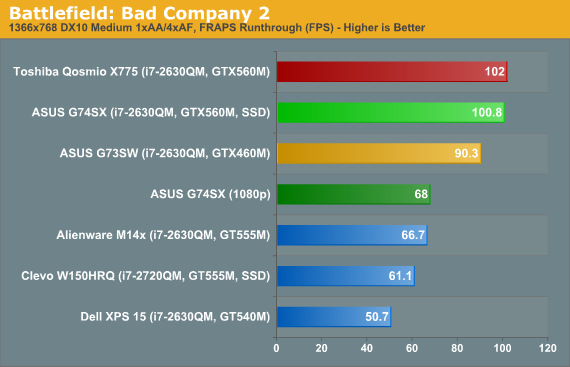
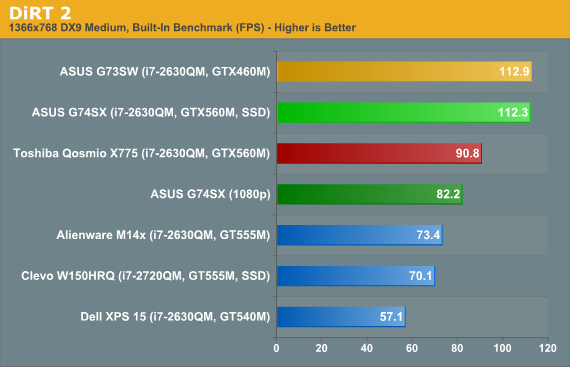
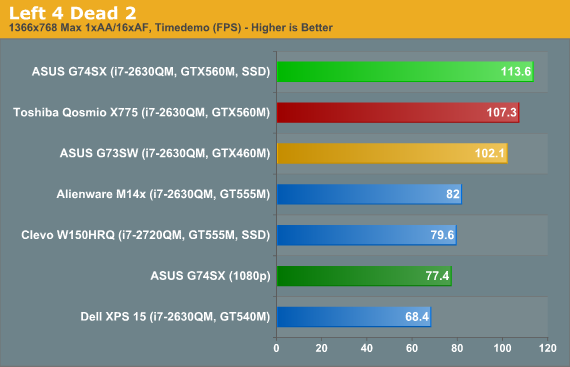
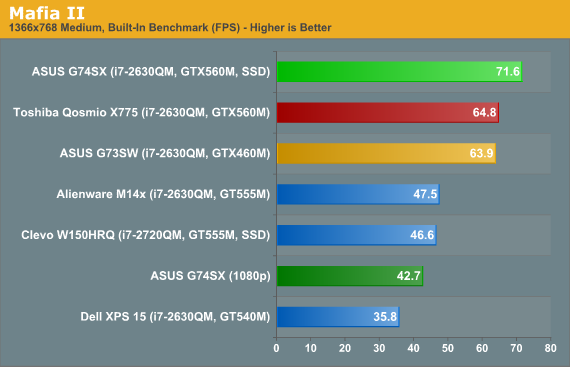

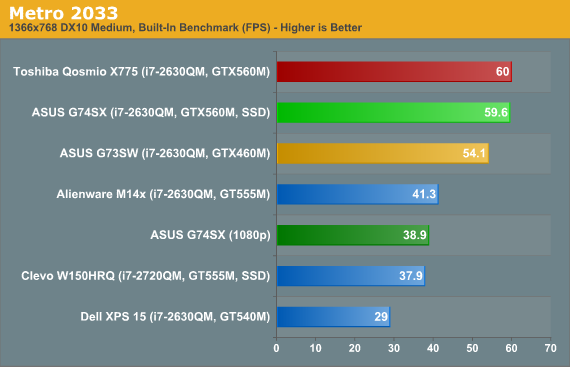
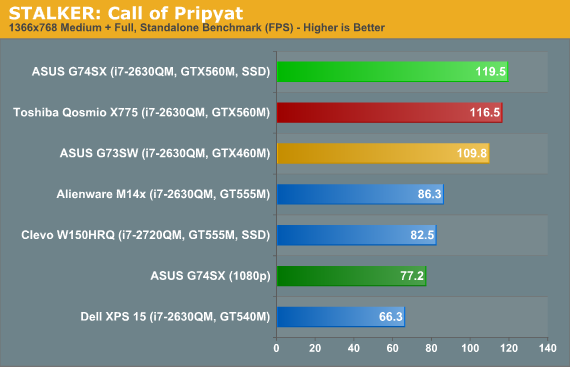
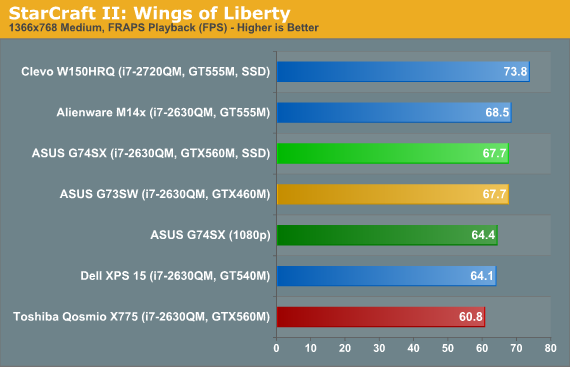
High Quality Gaming
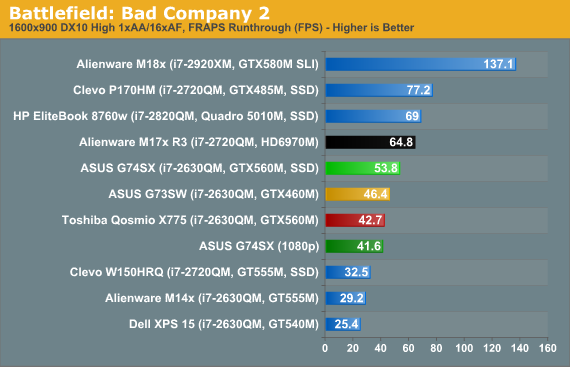
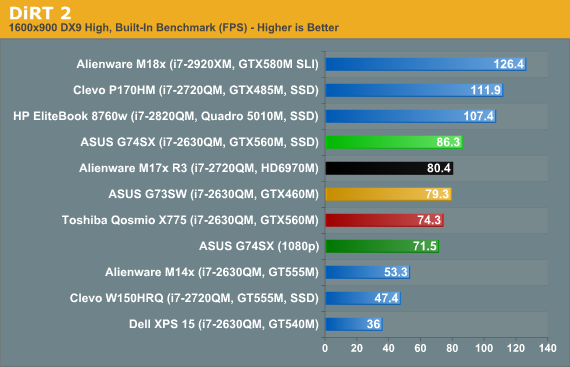
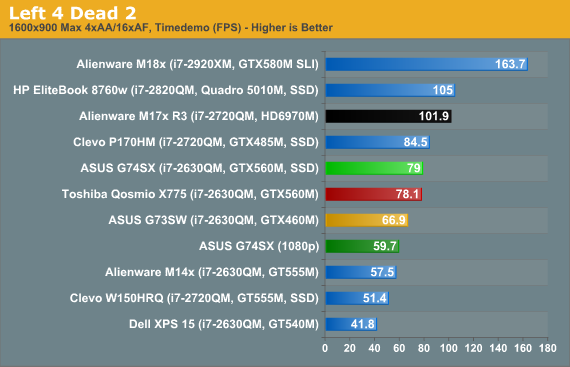
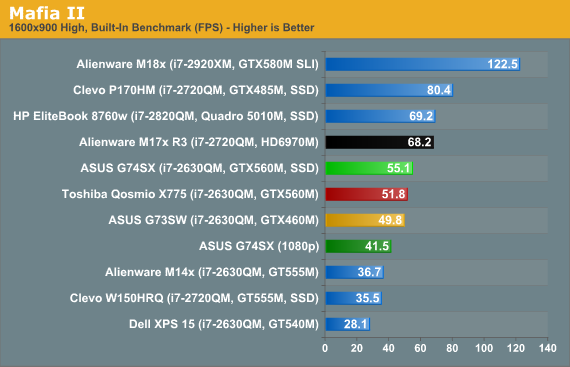
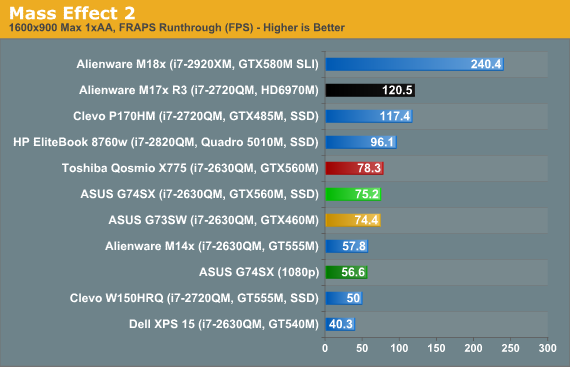
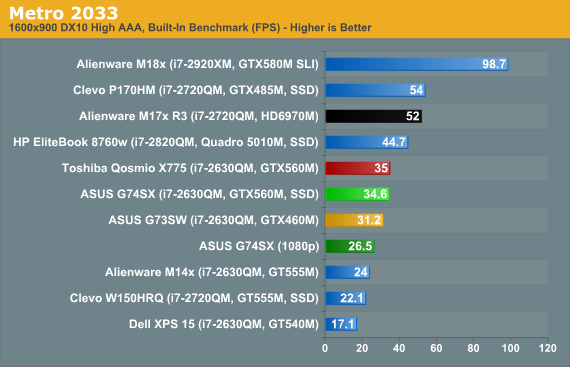
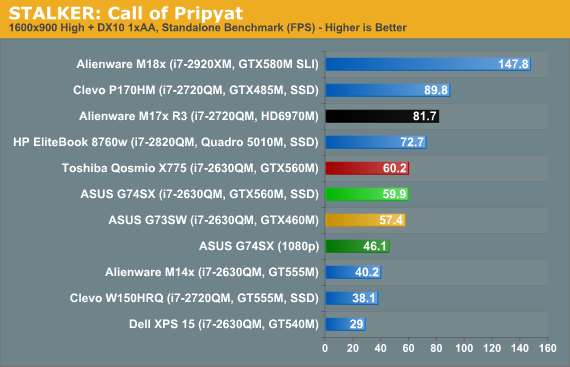
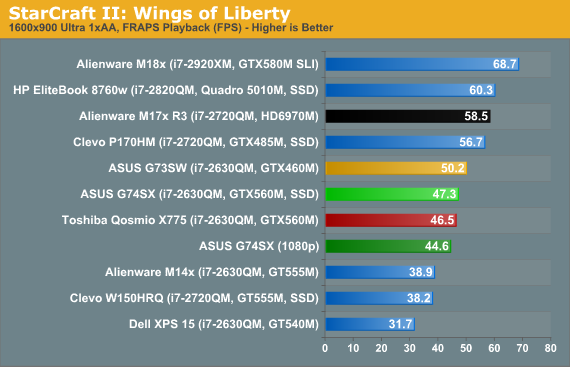
Ultra Quality Gaming
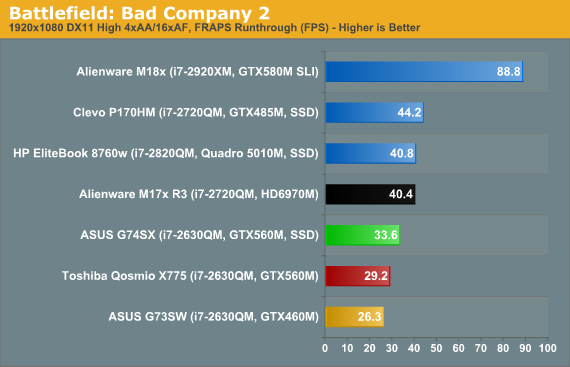
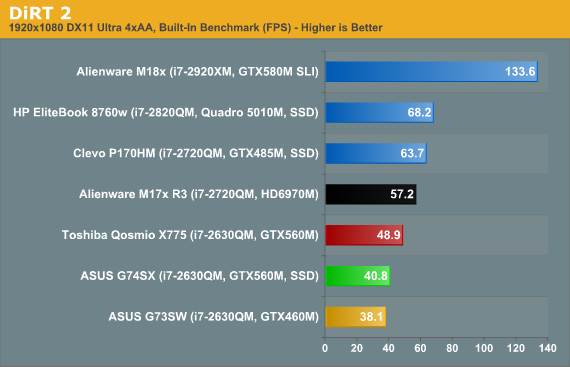
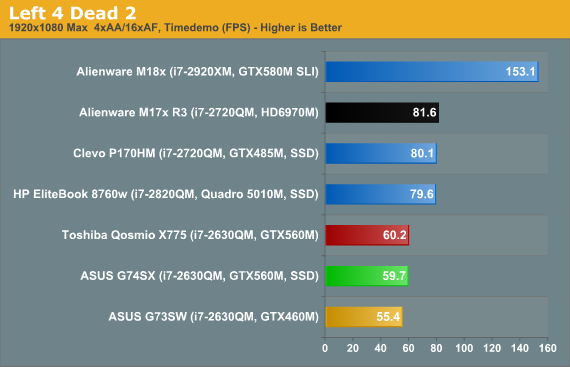
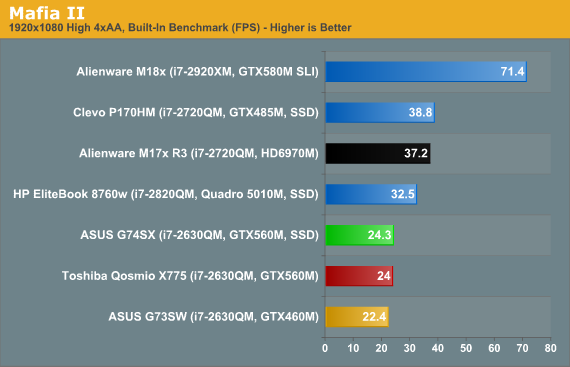
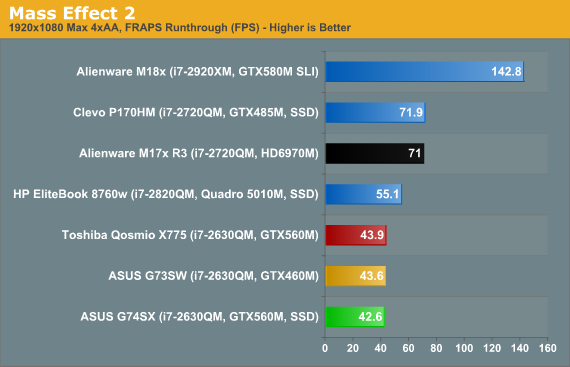

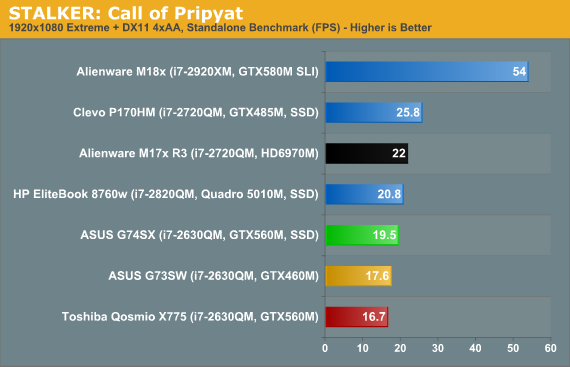
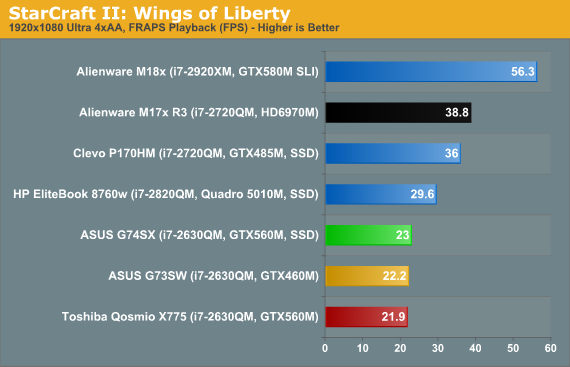
Medium quality gaming obviously doesn’t tax the GTX 560M all that much, and even at 1080p we see that results are generally higher than what the next step down (GT 555M) can manage at 768p. Toss in results from the GT 540M (Dell XPS 15) and we can see just how wide the gulf is between “mainstream” mobile gaming GPUs and “high-end” offerings. Really, if you want to play modern games on a laptop, the GT 540M should be your bare minimum GPU, and it’s only good for 768p and ~medium settings; if you want to play at 1080p, the GTX 560M is what you’ll want.
Looking at our eight titles (with a couple more in Mobile Bench), the G74SX can handle 1080p and our Medium settings in every single title while breaking 30FPS, and eight of the ten games break 60FPS. Move to 1080p and our High settings and nearly all of the games still remain above 30FPS, Metro 2033 being the one exception, but only one title (DiRT 2) can actually break 60FPS. When we turn on antialiasing, we clearly hit the limits of what the GTX 560M can handle. In our Ultra charts, half of the games still break 30FPS, but Mafia II, Metro, STALKER, and StarCraft II fall well short of the mark. You’ll want to monitor your use of antialiasing, and personally I find it too much for the G74SX at 1080p in the majority of titles; average frame rates may be reasonable, but 4xAA often introduces periodic stalls where you drop into the teens or even single digit frame rates, and I’d much rather sacrifice visual fidelity than deal with periodic choppiness.
One other interesting item in the above charts is the comparison of the G74SX with the Toshiba Qosmio. Toshiba employs Optimus Technology, but their laptop also felt a bit less optimized for performance, and it was running older NVIDIA drivers. How much each of those elements accounts for the gaming results is difficult to say, but while we see equal performance in some of the results (BFBC2 Medium, L4D2 High/Ultra, Mafia II Ultra, ME2, Metro Med/High, STALKER Med/High, and SC2 High/Ultra), there are also a few areas where the Qosmio is substantially slower. There’s a 20~25% gap in BFBC2 High and D2 Med/Ultra, and a 5~15% gap in BFBC2 Ultra, D2 High, L4D2 Med, Mafia2 Med/High, STALKER Ultra (unplayable though), and SC2 Med. We also see at least one instance (Metro Ultra) where the Qosmio comes in 73% faster (though it’s completely unplayable at <20FPS, regardless). Clearly, there are some differences in how the two notebooks perform, despite having nearly identical hardware (outside of Optimus support).










44 Comments
View All Comments
scottjames_12 - Thursday, October 6, 2011 - link
I'd be interested to know what you think of the MSI GT780DXR?JarredWalton - Thursday, October 6, 2011 - link
I'm trying to get one, so stay tuned. It looks better than the GT680R (GT683DXR), so maybe it will impress. We'll see if they send one (after the GeForce LAN party, where Ryan will see them).JojoKracko - Thursday, October 6, 2011 - link
No kidding. This is what I was expecting when I read Asus was updating the G74. It should have received a Matte Screen and the GTX570M.And if they were going to tweak the keyboard again, they should have fixed their cursor key positioning error. Move the cursor keys left and give the larger num pad zero key back. Nobody needs a triple or quad wide shift key on the keyboard, but anyone who used the number pad uses their thumb for the zero key - oops, can't do that any more cuz we like to fcuk stuff up!
JojoKracko - Saturday, October 15, 2011 - link
Indeed. Better GPU, better CPU in some options. Definitely better screen - because it is an anti-reflective MATTE FINISH.Oh, and don't make excuses for IPS panels not being put in $1500+ laptops. Shame the manufacturers for not doing so instead.
jigglywiggly - Thursday, October 6, 2011 - link
Too big for weak specs you can get in a np8130 15in.Dustin Sklavos - Thursday, October 6, 2011 - link
And all you have to do is sacrifice a drive bay and a usable keyboard!Thanks, I'll stick with the G74 or Alienware M17x. ;)
JarredWalton - Thursday, October 6, 2011 - link
Don't forget that maximum noise on this was just 37dB; the 15.6" Clevo laptops with similar specs can hit 45dB under full load!bennyg - Thursday, October 6, 2011 - link
I don't think anyone forking $1.5-2k on a gaming lappy is going to be listening to the onboard speakers, and any good pair of headphones either cancels or drowns out outside noise.Personally the noise doesn't bother me, I'd rather noisy, than toasty-and-dead-in-2-years.
Though, thankyou Asus and everyone else bar Toshiba (but theirs has a horrible LCD) for making my decision that bit easier for not including Optimus. I had no probs opting for a P150HM with 580M. Would have been a 6990M but for ATI's crappy driver GUI and functionality... as much as I thoroughly dislike Nvidia for their renaming antics they do have the better package.
The keyboard is a pain, but I'm really noticing just how great the backlit keyboard of my G51J was. That had a squished numpad as well and I grew to be fine with that. As you would when you spend FAR too long in front of the thing (workstation by day, plaything by night)
Iketh - Thursday, October 6, 2011 - link
When I'm working on my laptop, I'm usually not wearing headphones. I bet I'm not alone in this department. And yes, I put a load on mine when I work, not just when gaming.Also, you're implying the Clevo moves more air with that noise. I'm betting the Asus moves considerably more air than the Clevo, and it's hard to think otherwise if you've even taken a peek at Asus' cooling in their G series.
Wolfpup - Friday, October 7, 2011 - link
Yeah, at home I never use headphones, and I want the system as quiet as possible regardless of what I'm doing. 37 versus 45db is a pretty big gap.I'm tired of the "just crank it up!" argument for things that are too loud.
That's the same ridiculous thing I heard from people back before you could install games to the Xbox's hard drive, and that optical drive was so loud you couldn't think. "Just crank it up!" is not an actual solution to that problem.